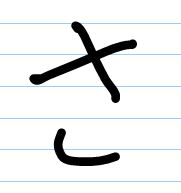See, the bottom and top don't touch - つながっていない. As I taught him I showed him the stroke order, and then we looked at a Japanese language learning website so he could see how the ひらがな looks in nice handwriting instead of my chicken scratch.
Then we happened upon そ. Like き and さ, I write it differently than it's seen in print:
It kind of has a てん on top, which isn't connected. I showed him, and then we looked at the site... which had written the character in one stroke instead:
Of course I deferred to the better handwriting, guessing that I had just internalized a certain way of writing based off my own (probably bad) habits. But today I happened upon a site that explained that both forms are completely valid. The only difference is that one is more common than the other, according to the Mr. Hideki Oshiki of the 押木研究室 at Joetsu University of Education:
社会的にどちらも「そ」という文字として認められています。一般的には「つながった字形」が多く使用されていますが、これは個人の使用に任せられていると考えられます。
Society accepts both forms of the character そ. The "connected form" is typically used more often, but this can be left up to the individual.Mr. Oshiki then goes into the a lot of detail concerning the origin of the character, which type is easier to write/has more 'impact', and how the connected form may have gained more precedence, among other things.
 |
| Image from 押木研究室 |
If you're interested in these kinds of questions, and in trends in calligraphy, the printing of Japanese characters and handwriting, you can find a good deal of information here. There is an English menu as well, and a list of recent updates which aren't reflected on the site's main page.
How do you write そ? Is yours つなげっている?Or つながっていない?



So is handwriting さ that is connected ダメ? I didn't remember learning that it wasn't connected until you brought it up, and I even remember writing it that way for a time, but somewhere along the line I got lazy I guess. My そ for whatever reason, I've never connected. However I got in big trouble beginning of 2nd year Japanese because my な was unacceptably lazy: I connected the top right stroke with the bottom right one. Neat post!
ReplyDeleteActually, Mr. Oshiki has an explanation for that, too: http://bit.ly/psY4vR From what I understood, like そ either is acceptable, but in the case of さ and き the unconnected form is what is taught and what is more often used in handwriting. He guesses that writing an uninterrupted stroke with a pencil/pen is more difficult than allowing a continued stroke with a brush, so the unconnected form became more popular.
ReplyDeleteConfession time - I, too, sometimes write my な with only three strokes...